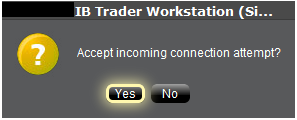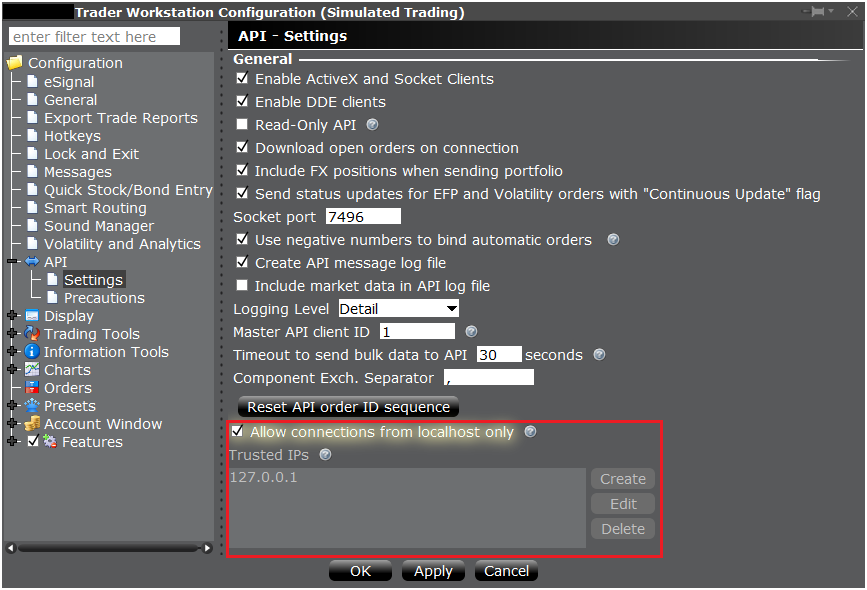 |
|
|
This documentation is now deprecated. Please switch to the IBKR Campus for up-to-date information regarding IBKR's API solutions. |
 |
|
|
This documentation is now deprecated. Please switch to the IBKR Campus for up-to-date information regarding IBKR's API solutions. |
A socket connection between the API client application and TWS is established with the IBApi.EClientSocket.eConnect function. TWS acts as a server to receive requests from the API application (the client) and responds by taking appropriate actions. The first step is for the API client to initiate a connection to TWS on a socket port where TWS is already listening. It is possible to have multiple TWS instances running on the same computer if each is configured with a different API socket port number. Also, each TWS session can receive up to 32 different client applications simultaneously. The client ID field specified in the API connection is used to distinguish different API clients.
Once our two main objects have been created, EWrapper and ESocketClient, the client application can connect via the IBApi.EClientSocket object:
eConnect starts by requesting from the operating system that a TCP socket be opened to the specified IP address and socket port. If the socket cannot be opened, the operating system (not TWS) returns an error which is received by the API client as error code 502 to IBApi.EWrapper.error (Note: since this error is not generated by TWS it is not captured in TWS log files). Most commonly error 502 will indicate that TWS is not running with the API enabled, or it is listening for connections on a different socket port. If connecting across a network, the error can also occur if there is a firewall or antivirus program blocking connections, or if the router's IP address is not listed in the "Trusted IPs" in TWS.
After the socket has been opened, there must be an initial handshake in which information is exchanged about the highest version supported by TWS and the API. This is important because API messages can have different lengths and fields in different versions and it is necessary to have a version number to interpret received messages correctly.
After the highest version number which can be used for communication is established, TWS will return certain pieces of data that correspond specifically to the logged-in TWS user's session. This includes (1) the account number(s) accessible in this TWS session, (2) the next valid order identifier (ID), and (3) the time of connection. In the most common mode of operation the EClient.AsyncEConnect field is set to false and the initial handshake is taken to completion immediately after the socket connection is established. TWS will then immediately provides the API client with this information.
There is an alternative, deprecated mode of connection used in special cases in which the variable AsyncEconnect is set to true, and the call to startAPI is only called from the connectAck() function. All IB samples use the mode AsyncEconnect = False.
API programs always have at least two threads of execution. One thread is used for sending messages to TWS, and another thread is used for reading returned messages. The second thread uses the API EReader class to read from the socket and add messages to a queue. Everytime a new message is added to the message queue, a notification flag is triggered to let other threads now that there is a message waiting to be processed. In the two-thread design of an API program, the message queue is also processed by the first thread. In a three-thread design, an additional thread is created to perform this task. The thread responsible for the message queue will decode messages and invoke the appropriate functions in EWrapper. The two-threaded design is used in the IB Python sample Program.py and the C++ sample TestCppClient, while the 'Testbed' samples in the other languages use a three-threaded design. Commonly in a Python asynchronous network application, the asyncio module will be used to create a more sequential looking code design.
The class which has functionality for reading and parsing raw messages from TWS is the IBApi.EReader class.
Now it is time to revisit the role of IBApi.EReaderSignal initially introduced in The EClientSocket Class. As mentioned in the previous paragraph, after the EReader thread places a message in the queue, a notification is issued to make known that a message is ready for processing. In the (C++, C#/.NET, Java) APIs, this is done via the IBApi.EReaderSignal object we initiated within the IBApi.EWrapper's implementer. In the Python API, it is handled automatically by the Queue class.
The client application is now ready to work with the Trader Workstation! At the completion of the connection, the API program will start receiving events such as IBApi.EWrapper.nextValidId and IBApi.EWrapper.managedAccounts. In TWS (not IB Gateway) if there is an active network connection, there will also immediately be callbacks to IBApi::EWrapper::error with errorId as -1 and errorCode=2104,2106, errorMsg = "Market Data Server is ok" to indicate there is an active connection to the IB market data server. Callbacks to IBApi::EWrapper::error with errorId as -1 do not represent true 'errors' but only notifications that a connection has been made successfully to the IB market data farms.
IB Gateway by contrast will not make connections to market data farms until a request is made by the IB client. Until this time the connection indicator in the IB Gateway GUI will show a yellow color of 'inactive' rather than an 'active' green indication.
When initially making requests from an API application it is important that the verifies that a response is received rather than proceeding assuming that the network connection is ok and the subscription request (portfolio updates, account information, etc) was made successfully.
For security reasons, by default the API is not configured to automatically accept connection requests from API applications. After a connection attempt, a dialogue will appear in TWS asking the user to manually confirm that a connection can be made:

To prevent the TWS from asking the end user to accept the connection, it is possible to configure it to automatically accept the connection from a trusted IP address and/or the local machine. This can easily be done via the TWS API settings:

Note: you have to make sure the connection has been fully established before attempting to do any requests to the TWS. Failure to do so will result in the TWS closing the connection. Typically this can be done by waiting for a callback from an event and the end of the initial connection handshake, such as IBApi.EWrapper.nextValidId or IBApi.EWrapper.managedAccounts.
In rare cases in which IB Gateway or TWS has a momentarily delay in establishing connecting to the IB servers, messages sent immediately after receiving the nextValidId could be dropped and would need to be resent. If the API client has not receive the expected callbacks from issued requests, it should not proceed assumming the connection is ok.
If there is a problem with the socket connection between TWS and the API client, for instance if TWS suddenly closes, this will trigger an exception in the EReader thread which is reading from the socket. This exception will also occur if an API client attempts to connect with a client ID that is already in use.
The socket EOF is handled slightly differently in different API languages. For instance in Java, it is caught and sent to the client application to IBApi::EWrapper::error with errorCode 507: "Bad Message". In C# it is caught and sent to IBApi::EWrapper::error with errorCode -1. The client application needs to handle this error message and use it to indicate that an exception has been thrown in the socket connection. Associated functions such as IBApi::EWrapper::connectionClosed and IBApi::EClient::IsConnected functions are not called automatically by the API code but need to be handled at the API client-level*.